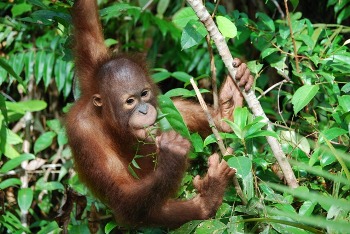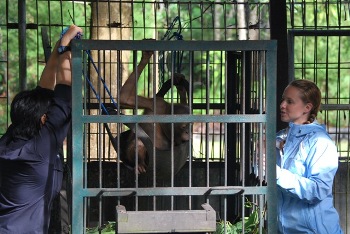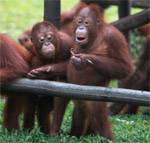Visitors to the Orangutan Care Center and Quarantine (OCCQ) are always delighted by the sight of playful young orangutans. Hairy orange youngsters swinging through the branches or tossing balls around always induce fits of cooing and camera clicking. These activities appear to be so natural that it is easy to forget these are orphans in rehabilitation school and one of the main classes is Enrichment. The term enrichment has become a catchword in the world of captive animal husbandry in the past few years and for many organizations, enrichment has become a new focus as more and more research reveals how critical enrichment is to the physical, mental, and emotional wellbeing of captive animals.
Enrichment is designed to improve the quality of captive animal life through the provision of novel objects and manipulation of their external environment. Enrichment keeps animals both mentally and physically stimulated in order to prevent boredom and depression and the development of obsessive compulsive behaviors like turning in circles, pacing, and self mutilation. Enrichment stimulates natural behaviors like play, foraging, problem solving, and social interaction between group members. Captive primates in particular thrive in conditions that mimic the complex socio-ecological challenges they have been faced with in the wild for millions of years. Conversely, they suffer more acutely in captivity when their external environment does not provide enough activities to engage the brain as it would be in the wild. For rehabilitation centers like the OCCQ, enrichment plays a particularly important role because it is an invaluable part of the learning process through which young orangutans acquire the skills needed to survive in the wild.
 Karbank demonstrates how important forest outings are for learning how to find and process wild foods. Photo courtesy of OCCQ. |
For the majority of orangutans in the rehabilitation program at the OCCQ, the most important enrichment that we can give them are daily trips to the surrounding 80 hectare forest. In the forest, the rehabilitants learn and practice the skills vital to their survival in the wild: locomotion, identification and processing of wild foods, nest building, and social interaction. Having the opportunity to explore, forage, and play encourages independence, learning, and intellectual development. In fact, these daily jungle outings are enjoyed to such an extent by the orangutans that the areas of forest where they play quickly turn into demolition zones from their rambunctious treetop games.
The two primary types of enclosure enrichment that are utilized at the OCCQ are emotional and cognitive. Emotional enrichment is provided to the young orangutans who have been emotionally traumatized by the loss of their mothers. The infants and young juveniles are held, cuddled, and caressed to simulate the intimate bond they would have had with their mothers in the wild; baby orangutans physically remain on their mother’s body for the first few years of their life and she is the source of all emotional nurturing and attachment in the wild. Female caregivers serve, therefore, as surrogate mothers, by providing emotional security until the young orangutans begin to mature. The use of surrogate caregivers is a critical part of the rehabilitation process because it instills psychological stability and competence in the younger orangutans, increasing the likelihood of successful rehabilitation later on.
 The local Enrichment coordinator, Ibu Mariyanti, and Jessica, Enrichment Intern, hang up a tire hammock for Sam to play with, sleep in and apparently, use as a chew toy. Photo courtesy of OCCQ. |
Cognitive enrichment at the OCCQ is a multifaceted endeavor to provide a mentally stimulating environment through a combination of natural and artificial items. Every day, fresh acacia branches are given to the orangutans for nesting, foraging, and playing. Swings, ladders, and hammocks made out of recycled tires are hung in enclosures to encourage physical activity through play. These often serve as a mental stimulator as well since the residents spend a great deal of time trying to work out how to dismantle the enrichment items. Small objects used for enrichment include locally produced rattan balls that are stuffed with peanuts and raisins. Peanut butter smeared on the inside of PVC pipes encourages the production and use of stick tools to extract the treat. Burlap and rice sacks and towels are given to provide warmth, comfort, and amusement. They can serve as hats, sleeping bags, seat cushions, and cloaks according to individual preference. Finally, edible fresh browse is gathered from the forest to provide additional nutrients and increased exposure to wild foods. To make objects even more enriching, they are placed in and around the enclosures so that the orangutans have to figure out how to acquire them before they get to use them. For example, branches are placed under, on top of, and hanging from the sides of the enclosures, requiring dexterous manipulation to bring them inside. After nests have been constructed, raisins, peanuts, and flowers can be hidden among the leaves and around the enclosure, creating a miniature scavenger hunt for the orangutans.
Enrichment is a very valuable tool for rehabilitation and serves the dual purpose of keeping residents physically active and mentally stimulated while preparing them for life in the wild. It also presents us with an opportunity to study captive orangutan behavior, monitor health and physical condition, and assess rehabilitation progress. Enrichment gives us a chance to be both observers and participants in the ancient and complex process of infant orangutans learning to be successful and independent ‘People of the Forest’.
Related articles
Orangutans use calls for a variety of reasons
(03/10/2010) Mature male orangutans produce what scientists call ‘long calls’, which can be heard for one kilometer in all directions even in dense forests. New research in Ethology has uncovered that these calls are employed for a number of reasons and provide information about who is calling and why.

(03/01/2010) It is no secret that orangutans are threatened with extinction because their rain forests are being destroyed at an alarming rate. Ten years ago, Shawn Thompson, a writer, former journalist and university professor, set out to chronicle the threat to orangutans in a book released in March 2010. The book is called The Intimate Ape: Orangutans and the Secret Life of a Vanishing Species. The book spends most of the time talking about the nature of orangutans and the relationships between orangutans and people. But the ultimate underlying message is there about the source of the peril to orangutans and the solution. Thompson says that the problem of saving orangutans has to do with communications and human nature.
Rehabilitation not enough to solve orangutan crisis in Indonesia

(08/20/2009) A baby orangutan ambles across the grass at the Borneo Orangutan Survival Foundation’s Nyaru Menteng rehabilitation center in Central Kalimantan, in the heart of Indonesian Borneo. The ape pauses, picks up a stick and makes his way over to a plastic log, lined with small holes. Breaking the stick in two, he pokes one end into a hole in an effort to extract honey that has been deposited by a conservation worker. His expression shows the tool’s use has been fruitful. But he is not alone. To his right another orangutan has turned half a coconut shell into a helmet, two others wrestle on the lawn, and another youngster scales a papaya tree. There are dozens of orangutans, all of which are about the same age. Just outside the compound, dozens of younger orangutans are getting climbing lessons from the Borneo Orangutan Survival Foundation (BOS) staff, while still younger orangutans are being fed milk from bottles in a nearby nursery. Still more orangutans—teenagers and adults—can be found on “Orangutan Island” beyond the center’s main grounds. Meanwhile several recently wild orangutans sit in cages. This is a waiting game. BOS hopes to eventually release all of these orangutans back into their natural habitat—the majestic rainforests and swampy peatlands of Central Kalimantan, on the island of Borneo. But for many, this is a fate that may never be realized.